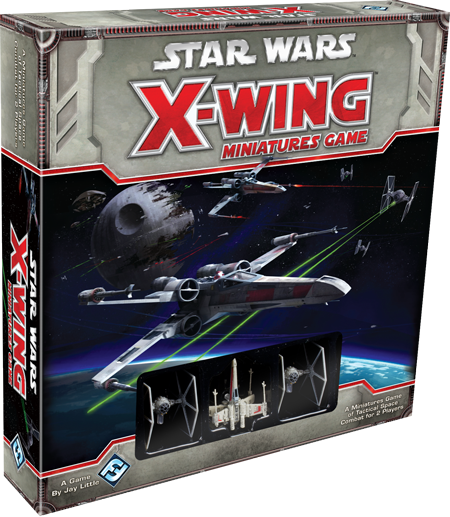Components: In the past, there have been some mediocre Stars Wars miniatures (I'm looking at you Star Wars: Starship Battles), but with Fantasy Flight behind the wheel we have some impressive offerings. These are easily some of the best pre-painted miniatures I have ever seen. The detail is very crisp for the scale (which comes in at approximately 1/270th) and the paint jobs are nice and clean. Fantasy Flight is using a harder, lighter plastic than other pre-painted minis games (like HeroClix, Dungeons & Dragons or Monsterpocalypse). As a result the ships feel a bit fragile (due to the light weight), but are surprisingly sturdy and don't suffer from the type of drooping/sagging/bending that plagues other minis. Additionally, the game comes with movements templates, tokens, dice and cards - all of which live up to the Fantasy Flight standard of quality.
The rulebook for X-Wing is nice, neat and accessible. The core box set has enough components for players to try a few scenarios (also included in the rulebook) and get a good grasp on both the basic and advanced rule sets that are presented. The rules themselves are intuitive to a point, though the interactions between ships while moving and the timing of certain abilities may pose a problem to players on occasion. Fantasy Flight recently released an FAQ/Errata document that clears up most of these issues.
Gameplay: X-Wing is a dogfighting game through and through. Players will build squadrons of fighters by selecting either named pilots (like Wedge Antilles or Howlrunner) or generic ones and equipping them with upgrade and skill cards. Pilots, equipment and skills all cost a certain number of points and currently, the standard game size is 100 points. This allows players to customize their squadron as they see fit and could mean as few as 3 or as many as 8 ships on the table depending on what a player choose.
The basic mechanic behind ship movement consists of players simultaneously selecting which move each ship in their squadron is going to perform via a set of dials unique to that ship. The maneuvers include things like simple moves forward, slight turns, sharp banks and the infamous Koiogran Turn (a simplified, Star Wars version of the Immelman Turn). Once players have set a dial and secretly placed it next to each corresponding fighter, they are revealed in ascending pilot order - each pilot having a skill number that determines just how good they are. Once a ship has moved, it can perform an action. Actions can range from improving your ability to evade, acquiring a target lock or even activating one of your upgrade cards.
 |
| Example of how the dials & movement templates work |
After all ships have moved, players will enter the combat phase and attempt to shoot each other down. This is as simple as checking to see who is in your firing arc (a 90 degrees wedge in front of every fighter), how far away they are (there are bonuses to attack for being at point blank range and bonuses to defense if you're far enough away) and building their dice pools. Attackers take a number of attack dice equal to their primary weapon value and roll them. After counting up how many hits they've scored, the defender will build a pool of green defense dice equal to their evasion and attempt to roll evade icons to cancel hits. There are rules for shields, critical hits and of course character abilities that alter the core mechanics of the game, but these are the basics.
 |
| Combat in action |
Overall: If you follow me on Twitter, then it won't surprise you to know that I'm in love with this game. Like, the scary kind of love that makes me want to tie it to a bed and break it's legs so it can't run away from me. Squad building is an exciting challenge and there's enough variety so far to keep squadrons fresh and games interesting. Both the Rebels and the Imperials seem to be well balanced against one another. However, since combat is dice based, there is a fair amount of luck involved and sometimes even your best laid plans can evaporate if you keep rolling blanks. Luckily, the game plays relatively quickly and the moments of bad-dice-temper-syndrome are likely to be few and far between.
The game is a bit pricey for a board game generally and a bit pricey for a miniatures game if you take into consideration how many models you get for the price - BUT, I find the depth and satisfaction I get out of the game makes this initial sticker shock completely irrelevant. X-Wing definitely delivers your money's worth and with new expansions coming out early next year, I don't think I'll be letting it collect dust any time soon.

No comments:
Post a Comment